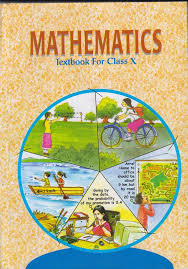Class 10 - Mathematics
Linear Equations In Two Variables - Exercise 3.3

Top Block 1
Exercise 3.3
Question : 1:Solve the following pair of linear equations by the substitution method.
(i) x + y = 14; x – y = 4
(ii) s – t = 3; s/3 + t/2 = 6
(iii) 3x – y = 3; 9x – 3y = 9
(iv) 0.2x + 0.3y = 1.3; 0.4x + 0.5y = 2.3
(v) √2x + √3y = 0; √3x – √8y = 0
(vi) 3x/2 – 5y/3 = -2; x/3 + y/2 = 13/6
Answer :
(i) x + y = 14 … (i)
x – y = 4 … (ii)
From equation (i), we get
x = 14 – y … (iii)
Putting this value in equation (ii), we get
(14 – y) – y = 4
14 – 2y = 4
10 = 2y
y = 5 … (iv)
Putting this in equation (iii), we get
x = 9
So, x = 9 and y = 5
(ii) s – t = 3 … (i)
s/3 + t/2 = 6 … (ii)
From equation (i), we get s = t + 3
Putting this value in equation (ii), we get
t + 3/3 + t/2 = 6
2t + 6 + 3t = 36
5t = 30
t = 30/5 … (iv)
Putting in equation (iii), we get
s = 9
So, s = 9, t = 6
(iii) 3x – y = 3 … (i)
9x – 3y = 9 … (ii)
From equation (i), we get
y = 3x – 3 … (iii)
Putting this value in equation (ii), we get
9x – 3(3x – 3) = 9
9x – 9x + 9 = 9
9 = 9
This is always true.
Hence, the given pair of equations has infinite possible solutions and the relation between these variables can be given by y = 3x – 3
Therefore, one of its possible solutions is x = 1, y = 0.
(iv) 0.2x + 0.3y = 1.3 … (i)
0.4x + 0.5y = 2.3 … (ii)
0.2x + 0.3y = 1.3
Solving equation (i), we get
0.2x = 1.3 – 0.3y
Dividing by 0.2, we get
x = 1.3/0.2 – 0.3/0.2
x = 6.5 – 1.5 y … (iii)
Putting the value in equation (ii), we get
0.4x + 0.5y = 2.3
(6.5 – 1.5y) × 0.4x + 0.5y = 2.3
2.6 – 0.6y + 0.5y = 2.3
–0.1y = 2.3 – 2.6
y = – 0.3/–0.1
y = 3
Putting this value in equation (iii) we get
x = 6.5 – 1.5 y
x = 6.5 – 1.5(3)
x = 6.5 – 4.5
x = 2
So, x = 2 and y = 3
(v) √2x + √3y = 0 …………..1
√3x – √8y = 0 ………….2
From equation 1, we get
y = -√2x/√3 ………….3
Put value of y in equation 2, we get
√3x – √2(-√2x/√3) = 0
3x – 2x = 0
x = 0
Put value ox in equation 3, we get
y = 0
Hence, x = 0, y = 0
(vi) 3x/2 – 5y/3 = -2 ………1
x/3 + y/2 = 13/6 …………….2
From equation 1, we get
5y/3 = 3x/2 + 2
5y/3 = (3x + 4)/2
y = 3(3x + 4)/(2 * 5)
y = (9x + 12)/10 ………3
Put value of y in equation 2, we get
x/3 + (1/2) * (9x + 12)/10 = 13/6
⇒ (20x + 27x + 36)/60 = 13/6
⇒ (47x + 36)/60 = 13/6
⇒ (47x + 36)/10 = 13
⇒ 47x + 36 = 13 * 10
⇒ 47x + 36 = 130
⇒ 47x = 130 – 36
⇒ 47x = 94 ⇒ x = 94/47 ⇒ x = 2
Put value of x in equation 3, we get
y = (9 * 2 + 12)/10
⇒ y = (18 + 12)/10
⇒ y = 30/10
⇒ y = 3 Hence, x = 2, y = 3
Question : 2:Solve 2x + 3y = 11 and 2x – 4y = – 24 and hence find the value of ‘m’ for which y = mx + 3.
Answer :
Given, 2x + 3y = 11 … (i)
Subtracting 3y both side we get
2x = 11 – 3y … (ii)
Putting this value in equation second we get
2x – 4y = – 24 … (iii)
11- 3y – 4y = – 24
7y = – 24 – 11
–7y = – 35
y = – 35/–7
y = 5
Putting this value in equation (iii) we get
2x = 11 – 3 * 5
2x = 11 – 15
2x = – 4
Dividing by 2 we get
x = – 2
Putting the value of x and y
y = mx + 3
5 = – 2m + 3
2m = 3 – 5
m = – 2/2 or, m = – 1
Question : 3:Form the pair of linear equations for the following problems and find their solution by substitution method.
(i) The difference between two numbers is 26 and one number is three times the other. Find them.
(ii) The larger of two supplementary angles exceeds the smaller by 18 degrees. Find them.
(iii) The coach of a cricket team buys 7 bats and 6 balls for Rs 3800. Later, she buys 3 bats and 5 balls for Rs 1750.
Find the cost of each bat and each ball.
(iv) The taxi charges in a city consist of a fixed charge together with the charge for the distance covered. For a distance of 10 km,
he charge paid is Rs 105 and for a journey of 15 km, the charge paid is Rs 155.
What are the fixed charges and the charge per km? How much does a person have to pay for travelling a distance of 25 km?
(v) A fraction becomes 9/11, if 2 is added to both the numerator and the denominator.
If, 3 is added to both the numerator and the denominator it becomes 5/6. Find the fraction.
(vi) Five years hence, the age of Jacob will be three times that of his son.
Five years ago, Jacob’s age was seven times that of his son. What are their present ages?
Answer :
(i) Let the larger number be = x
Let the smaller number be = y
The difference between the two numbers is 26
x – y = 26
x = 26 + y
Given that one number is three times the other
So, x = 3y
Putting the value of x we get
26 + y = 3y
–2y = – 2 6
y = 13
Putting value of y, we get
x = 3 * 13 = 39
Therefore the numbers are 13 and 39.
(ii)Let the first angle be= x
and the second angle be = y
As both angles are supplementary so that sum will 180
x + y = 180
x = 180 – y … (i)
Given; difference is 18 degree
Therefore, x – y = 18
Putting the value of x we get
180 – y – y = 18
– 2y = – 162
y = – 162/–2
y = 81
Putting the value back in equation (i), we get
x = 180 – 81 = 99
Hence, the angles are 99° and 81°.
Mddle block 1
Let the cost of each ball be = Rs y
Given: coach of a cricket team buys 7 bats and 6 balls for Rs 3800.
7x + 6y = 3800
6y = 3800 – 7x
Dividing by 6, we get
y = (3800 – 7x)/6 ……….. (i)
Given that she buys 3 bats and 5 balls for Rs 1750 later.
3x + 5y = 1750
Putting the value of y
3x + 5 ((3800 – 7x)/6) = 1750
Multiplying by 6, we get
18x + 19000 – 35x = 10500
–17x =10500 – 19000
–17x = – 8500
x = – 8500/–17
x = 500
Putting this value in equation (i) we get
y = (3800 – 7 * 500)/6
y = 300/6
y = 50
Hence the cost of each bat = Rs 500 and the cost of each balls = Rs 50.
(iv) Let the fixed charge for taxi = Rs x
and variable cost per km = Rs y
Total cost = fixed charge + variable charge
Given that for a distance of 10 km, the charge paid is Rs 105
x + 10y = 105 … (i)
x = 105 – 10y
Given that for a journey of 15 km, the charge paid is Rs 155
x + 15y = 155
Putting the value of x we get
105 – 10y + 15y = 155
5y = 155 – 105
5y = 50
Dividing by 5, we get
y = 50/5 = 10
Putting this value in equation (i) we get
x = 105 – 10 * 10
x = 5
Cost for traveling a distance of 25 km = x + 25y
= 5 + 25 * 10
= 5 + 250
=255
A person has to pay Rs 255 for 25 Km.
(v) Let the Numerator be = x
Let the Denominator be = y
Fraction = x/y
A fraction becomes 9/11, if 2 is added to both the numerator and the denominator
(x + 2)/y + 2 = 9/11
On Cross multiplying,
11x + 22 = 9y + 18
Subtracting 22 from both sides,
11x = 9y – 4
Dividing by 11, we get
x = (9y – 4)/11 … (i)
Given: if 3 is added to both the numerator and the denominator it becomes 5/6.
(x + 3)/(y + 3) = 5/6 … (ii)
On Cross multiplying,
6x + 18 = 5y + 15
Subtracting the value of x, we get
6(9y – 4 )/11 + 18 = 5y + 15
Subtracting 18 from both the sides
6(9y – 4 )/11 = 5y – 3
54 – 24 = 55y – 33
–y = – 9
y = 9
Putting this value of y in equation (i), we get
x = (9y – 4)/11 … (i)
x = (81 – 4)/77
x = 77/11
x = 7
Hence our fraction is 7/9.
(vi) Let the present age of Jacob be = x year
and the present Age of his son be = y year
Five years from now,
Jacob’s age will be = x + 5 year
Age of his son will be = y + 5year
Given; the age of Jacob will be three times that of his son
x + 5 = 3(y + 5)
Adding 5 to both side,
x = 3y + 15 – 5
x = 3y + 10 … (i)
Five years ago,
Jacob’s age= x – 5 year
His son’s age = y – 5 year
Jacob’s age was seven times that of his son
x – 5 = 7(y – 5)
Putting the value of x from equation (i) we get
3y + 10 – 5 = 7y – 35
3y + 5 = 7y – 35
3y – 7y = – 35 – 5
–4y = – 40
y = – 40/–4
y = 10 year
Putting the value of y in equation we get
x = 3 * 10 + 10
x = 40 years
Hence, Present age of Jacob = 40 years and present age of his son = 10 years.

